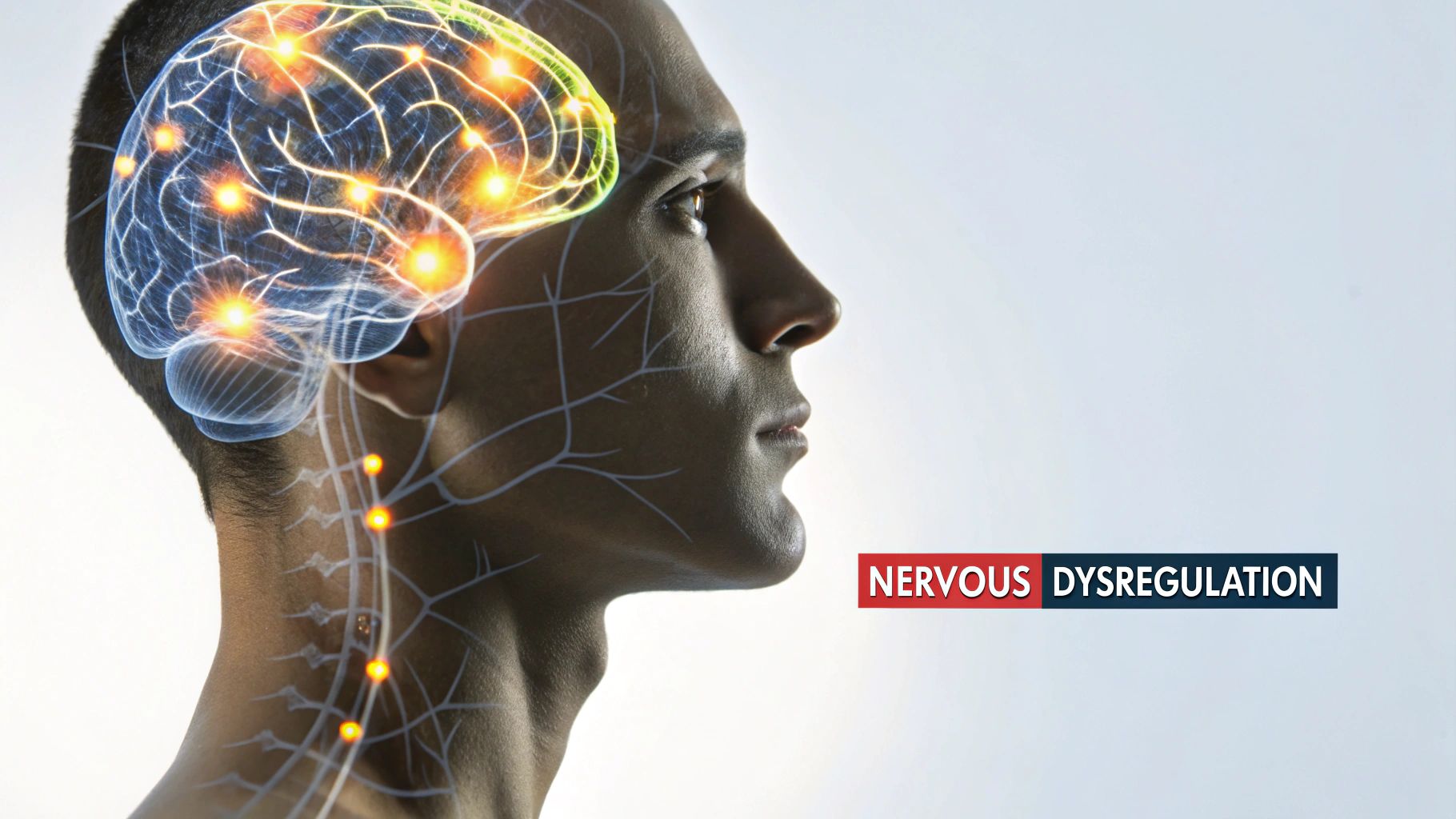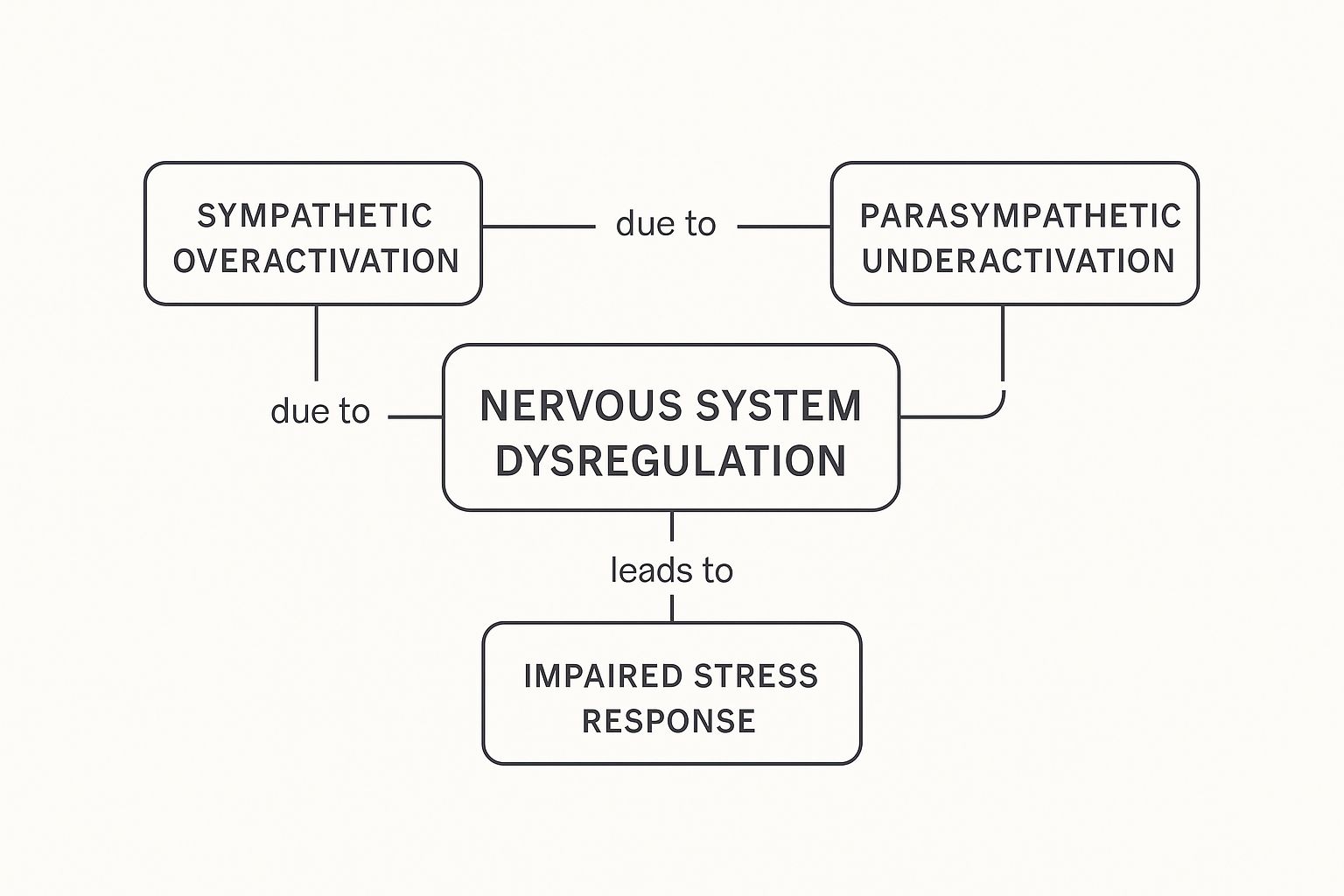When your nervous system is dysregulated, it’s like your body’s internal alarm system has gotten stuck. Instead of reacting to stress and then returning to a calm state, it’s either locked in 'high gear'—think anxiety and panic—or it’s stalled out completely in a state of fatigue and shutdown. This imbalance disrupts your fundamental ability to feel balanced, grounded, and safe.
What It Feels Like to Have a Dysregulated Nervous System

Let’s use an analogy. Think of your nervous system as the gas and brake pedals in your car. The gas pedal is your sympathetic nervous system, which revs you up for action. This is your classic "fight-or-flight" response. The brake is your parasympathetic nervous system, the one that helps you slow down, rest, and recover.
In a healthy, well-regulated system, you can press the gas to handle a stressful deadline at work, then ease onto the brake to relax with your family afterward. You move smoothly and appropriately between these two states.
But when dysregulation takes hold, it's as if those pedals are malfunctioning. Your foot is either slammed on the gas with no way to brake, or the brake is pushed to the floor, and you can't get the car to move at all. You’ve lost control of the vehicle.
To get a clearer picture, this table breaks down the differences between a regulated and a dysregulated state.
Regulated vs Dysregulated Nervous System A Quick Comparison
| Symptom Area | Signs of a Regulated System (Balanced) | Signs of a Dysregulated System (Imbalanced) |
|---|---|---|
| Physical | Calm breathing, relaxed muscles, consistent energy | Chronic tension, digestive issues, fatigue, sleep problems, racing heart |
| Emotional | Can manage emotions, feels grounded, resilient to stress | Anxiety, depression, irritability, emotional numbness, easily overwhelmed |
| Behavioral | Socially engaged, focused, adaptable to change | Avoidance, hypervigilance, difficulty concentrating, social withdrawal |
This comparison highlights how deeply dysregulation can impact every aspect of daily life, turning everyday challenges into overwhelming obstacles.
When Your Gas Pedal Is Stuck
Living with a constantly activated sympathetic nervous system feels like being perpetually on edge. Your internal engine is always running hot, even when there's no real threat in sight. This state of overdrive can show up in a few key ways:
- Constant Anxiety: That nagging feeling of dread or worry that you just can't seem to shake.
- Irritability and Agitation: Small inconveniences feel like major crises, and your patience is worn incredibly thin.
- Hypervigilance: You're always scanning your environment for potential threats, making it impossible to truly relax.
- Racing Thoughts: Your mind jumps from one worry to the next without giving you a moment of peace.
This isn't just "in your head"—it's a very real physical state. Your body is flooded with stress hormones like cortisol and adrenaline, constantly prepping you for a danger that never actually arrives. The result is total exhaustion from being in a constant state of high alert.
When Your Brake Pedal Is Stuck
On the flip side, dysregulation can slam on the brakes, pushing you into a state of shutdown or "hypo-arousal." This isn't relaxation; it's a profound lack of energy, connection, and engagement with the world around you.
This state of shutdown is actually a protective mechanism. When the body perceives a threat as too overwhelming to fight or flee from, it may "freeze" to conserve energy and numb itself from the experience.
Signs that your system is stuck on the brake include:
- Chronic Fatigue: A deep, persistent exhaustion that no amount of sleep seems to fix.
- Feeling Numb: An emotional flatness or a sense of being disconnected from yourself and others.
- Brain Fog: Having trouble concentrating, remembering things, or even making simple decisions.
- Lack of Motivation: A feeling of being stuck or paralyzed, completely unable to initiate tasks.
Learning to spot these signals is the first step toward recognizing the imbalance. Advanced tools can give us an even clearer picture of what's happening inside your nervous system; you can learn more about Insight Scans for the nervous system in our detailed guide. Recognizing these feelings validates that what you're experiencing has a real, biological basis, which opens the door for targeted, effective support.
The Science Behind Feeling Overwhelmed
To really get what’s happening when you feel constantly on edge or totally checked out, we have to look at your body’s control center: the Autonomic Nervous System (ANS). This is the part of your nervous system working tirelessly in the background, managing things like your heart rate, breathing, and digestion without you ever having to think about it. Its main job is to keep you safe and stable.
A great way to picture your capacity to handle life’s stressors is with an analogy called the “Window of Tolerance.” When you’re operating inside this window, you feel grounded, present, and totally capable of navigating whatever comes your way. But when chronic stress, illness, or trauma piles up, that window can start to shrink, making it way easier to get pushed into a state of overwhelm.
Get pushed out one side of the window, and you’re in hyper-arousal. This is that classic “fight-or-flight” sympathetic state we’ve all heard about, leaving you feeling anxious, agitated, and frazzled. If you get pushed out the other side, you land in hypo-arousal, a state of shutdown where you feel numb, disconnected, and completely exhausted.
The Three States of Your Nervous System
The Polyvagal Theory gives us a fantastic roadmap for understanding these different gears our nervous system can shift into. It breaks it down into three primary states, each tied to a specific part of the vagus nerve and wired for our survival.
- Ventral Vagal (Safe & Social): This is your sweet spot, your true Window of Tolerance. When you're in this state, you feel safe, connected, and ready to engage with the world calmly and curiously.
- Sympathetic (Mobilized): When your brain perceives a threat, this system jumps into action. It floods your body with adrenaline and cortisol, giving you the energy to either fight the threat or run from it. Think racing heart, quick breathing, and tunnel vision.
- Dorsal Vagal (Shutdown): If a threat feels too big to fight or escape, this ancient, primal system takes over as a last resort. It’s a self-preservation move that leads to freezing, numbness, and disconnection—that hypo-arousal state we just mentioned.
This is a great visual for how these systems play a role in nervous system dysregulation.

As you can see, dysregulation is all about imbalance. It can mean the sympathetic system is stuck in overdrive, the calming parasympathetic system is underactive, or the whole stress response system is just plain worn out.
Why Your Body Gets Stuck
So, what is nervous system dysregulation at its core? It’s what happens when your body gets stuck in either that revved-up sympathetic state or that shut-down dorsal vagal state, unable to find its way back to the calm of the ventral vagal zone. Your brain essentially keeps sounding the alarm, perceiving danger even when you’re perfectly safe.
This isn't a sign of weakness; it’s your biology trying to protect you. Your nervous system has learned from past experiences that it needs to stay on high alert or shut down to survive, and it hasn't yet learned that the danger has passed.
Living in a constant state of alert or shutdown is incredibly taxing on your body. It messes with everything from your immune system and digestion to your ability to get a good night's sleep or connect with the people you love. Understanding this science is the first step. It helps you see that these feelings have a deep physiological root—and that healing is all about teaching your body how to feel safe again.
Understanding the Triggers Behind Dysregulation

So, what exactly pushes the nervous system out of that calm, balanced state? The triggers are usually a combination of big, sudden events and the slow, steady drip of everyday pressures. Getting a handle on these sources is the first step in seeing nervous system dysregulation for what it really is—not a personal failing, but your body’s smart, protective response to being totally overwhelmed.
I like to use the analogy of a bucket to explain our capacity for stress. A single, massive event can fill it to the brim in an instant. But more often, it’s the smaller, chronic stressors that slowly fill it drop by drop until one day, it overflows.
Major Stressors and Chronic Pressures
Acute trauma is one of the most powerful triggers out there. We’re talking about events that feel life-threatening or deeply shocking, causing your system to slam on the brakes and get locked into a "fight, flight, or freeze" mode.
- Sudden Traumatic Events: A car accident, a bad fall, or even a natural disaster can instantly overload the nervous system’s circuits.
- Significant Life Changes: Even good things like starting a new job or moving to a new city can be intensely stressful. And of course, difficult events like a divorce or losing a loved one deliver a profound shock to the system.
But it’s often the relentless, low-grade stressors that do the most damage over time. These are the pressures that build up over months or even years, keeping your body in a subtle but constant state of high alert.
It's crucial to remember that nervous system dysregulation is a survival mechanism. Your body is doing exactly what it was designed to do when it senses a threat—the problem is that it gets stuck in that mode long after the danger has passed.
The Role of Physical Health
It’s not just emotional or situational stress that tips the scales. Your physical health plays a huge role in your nervous system's ability to stay balanced and bounce back from life’s challenges. These internal stressors can keep the alarm bells ringing just as loudly as any external threat.
Some of the key physiological factors include:
- Chronic Inflammation: When your body is constantly fighting inflammation from diet, illness, or an old injury, it sends continuous danger signals to your brain.
- Poor Sleep: Without enough restorative sleep, your nervous system never gets the chance to run its nightly "reset" and repair cycle.
- Nutritional Deficiencies: A lack of essential vitamins and minerals can throw off the neurotransmitters that help regulate your mood and stress response.
- Sensory Overload: For many people, especially kids, being constantly bombarded with overwhelming sensory input can push their system into dysregulation. For parents, understanding the signs of sensory processing disorder can be a game-changer.
Once you start identifying these root causes, you can begin to see your experience in a new light. Dysregulation doesn't mean you're broken; it means your body has been working incredibly hard to protect you through some tough circumstances. That shift in perspective is the first real step toward healing.
How Dysregulation Shows Up at Different Ages
Nervous system dysregulation isn’t a one-size-fits-all problem. It wears different masks at every stage of life, and what looks like colic in a baby can later show up as academic burnout in a teen. Learning to spot these age-specific signs is key to seeing the real issue: a nervous system stuck in overdrive.
For parents, catching these patterns early can be a total game-changer. It shifts your focus from just managing tough behaviors to healing the underlying neurological stress that’s causing them in the first place.
In Infants and Young Children
From the moment they’re born, a baby’s nervous system is working hard to make sense of a brand-new world full of sights, sounds, and sensations. When that system gets overwhelmed and can't find its footing, it shows up in ways that are all too often brushed off as “just a phase.”
Signs of nervous system dysregulation in babies and toddlers often include:
- Intense Colic: This isn’t just normal fussiness. We’re talking about hours of inconsolable crying, often with a rigid, arched back that signals deep internal distress.
- Feeding Difficulties: Struggles with latching, coordinating the suck-swallow-breathe rhythm, or major reflux issues can all be signs of neurological interference.
- Sensory Sensitivities: Extreme reactions to everyday things like loud noises, bright lights, or even the feeling of a tag on their clothing.
- Frequent, Overwhelming Tantrums: Meltdowns that are far more intense and common than what’s typical for their age, showing they just can’t calm themselves down.
These early signs aren't just things to be powered through. They are your child's way of telling you that their internal "alarm system" is stuck on high alert, making it nearly impossible for them to feel safe and settled.
In Teenagers and Adolescents
As kids enter the teenage years, the pressures pile on—school, friends, and hormones create a perfect storm of stress. For a teen whose system is already dysregulated, this time can feel completely overwhelming, and their struggles often get mislabeled as simple moodiness or defiance.
In teens, dysregulation frequently appears as:
- Social Anxiety: An intense fear of social situations that causes them to avoid friends, school events, or even just going out in public.
- Academic Burnout: They might have trouble concentrating, put things off constantly, or see a sudden drop in their grades because they’re just mentally and physically drained.
- Emotional Volatility: Extreme mood swings, constant irritability, and an inability to handle even small frustrations or disappointments.
- Risk-Taking Behaviors: Acting impulsively or engaging in dangerous activities, either to feel something or to try and self-soothe a system that won’t shut off.
In Adults
By the time we reach adulthood, chronic nervous system dysregulation can be so deeply wired into our bodies that it fuels a whole host of health problems that seem to have no connection. The body has been running on stress for so long that being sick and tired just becomes the new normal.
Common signs in adults include:
- Chronic Digestive Issues: Constant battles with IBS, bloating, or acid reflux that never seem to get better, no matter what you eat.
- Persistent Fatigue and Brain Fog: A deep-seated exhaustion and mental cloudiness that no amount of sleep or coffee can seem to fix.
- Mental Health Struggles: An ongoing fight with anxiety, depression, or panic attacks that feels impossible to win.
- Autoimmune Conditions: A chronically stressed nervous system can fan the flames of conditions like fibromyalgia or rheumatoid arthritis.
The scale of this problem is staggering. In 2021, neurological conditions impacted over 3.4 billion people across the globe, making them the number one cause of disability worldwide. You can learn more about the global impact of these conditions right here. Recognizing these patterns as they pop up throughout life makes one thing clear: addressing this early is the best way to build a healthier, more resilient future.
How Chiropractic Care Can Restore Nervous System Balance

When your nervous system is stuck in a state of dysregulation, just trying to "calm down" rarely works. It's not a matter of willpower. The body is physically locked in a stress pattern that it can't break on its own, and this is where specialized chiropractic care comes in. It offers a direct, gentle way to communicate with the nervous system and help it find its way back to balance.
Our approach is called neuro-tonal chiropractic, and it’s different from what many people think of as traditional chiropractic. Instead of just focusing on the alignment of the spine, we work to recalibrate the actual "tone" or tension held within your nervous system.
Think of your nervous system like a guitar string. If the string is pulled way too tight—that’s a high-tone, sympathetic state—the music it makes is harsh and jarring. If it’s too loose and floppy, like a low-tone or hypo-aroused state, the sound is dull and lifeless. Neuro-tonal care is all about gently tuning that string to restore its ideal tension so your body can function beautifully again.
Addressing the Root Cause of Interference
The core issue we almost always find is something we call neurological interference, or a subluxation. This happens when physical, chemical, or emotional stress causes a misalignment in the spine that disrupts the vital communication highway between your brain and your body.
This interference acts just like static on a phone line, preventing clear signals from getting through. Your brain can no longer get an accurate picture of what’s happening in your body or the world around you, so it defaults to a state of high alert. This is how the body gets stuck in a chronic "fight-or-flight" loop, even when there's no real danger present.
When the body is in a constant state of defense, it cannot properly rest, digest, or heal. The goal of neuro-tonal chiropractic is to gently remove this interference, allowing the nervous system to shift out of survival mode and back into a state of growth and repair.
This proactive approach is becoming more critical than ever. The global burden of brain and nervous system disorders is on the rise, with forecasts suggesting that by 2050, the number of people affected will reach a staggering 4.9 billion. That’s a 22% increase from 2021, and it presents a massive challenge for families and our healthcare systems. You can read more about these projections and the urgent need for preventive strategies to address nervous system dysregulation in this detailed neurology study.
How Gentle Adjustments Restore Balance
Unlike the forceful manipulations some people imagine, neuro-tonal adjustments are incredibly gentle, specific, and precise. They are carefully designed to send a clear, calming signal directly to the brain.
This gentle input essentially tells the brain that it's safe to let go of stored tension and finally exit that "fight-or-flight" state. By doing this, we help the body activate its parasympathetic nervous system—the "brake pedal" that is absolutely essential for rest, digestion, and healing.
This process helps restore the body’s innate, God-given ability to self-regulate. We aren't just managing symptoms like anxiety or fatigue; we are getting to the underlying cause of the nervous system dysregulation. Our work in functional neurology chiropractic provides a much deeper look into how these adjustments can actually retrain the brain for better, more resilient function.
When this balance is restored, families often see incredible changes, including:
- Improved sleep quality and duration
- Enhanced emotional regulation and resilience
- Better focus and cognitive clarity
- Improved digestive and immune function
Ultimately, our care helps create a solid foundation for lasting health, allowing your body to heal itself from the inside out, just as it was designed to do.
Your Path Toward a Regulated and Resilient Life
Living a regulated, balanced life isn’t about trying to get rid of all your stress—that’s just not realistic. It’s about building up your **resilience** so you can handle life’s curveballs without getting completely knocked off your feet.
Here's the key takeaway: your nervous system isn't permanently broken. It’s absolutely possible to retrain it. You can actively work on expanding your Window of Tolerance, which gives you a greater capacity to face stressors with a sense of calm and clarity.
This journey back to balance is an active one. While neuro-tonal chiropractic care lays a powerful foundation by getting to the root of the interference, it delivers the best results when you pair it with supportive daily habits. These simple practices help lock in the new, calmer patterns your brain and body are learning.
Integrating Supportive Practices
Think of these practices like making small, consistent deposits into your wellness bank account. They don’t have to be complicated or time-consuming to make a real difference.
- Mindful Breathwork: Something as simple as box breathing can instantly engage your parasympathetic nervous system. Just inhale for a count of four, hold for four, exhale for four, and hold for four. This sends a direct "you are safe" signal to your brain.
- Gentle Movement: Activities like walking in nature, doing some light stretching, or yoga are fantastic for releasing stored physical tension. Movement is one of the best ways to help your body process and flush out stress hormones.
- Sensory Grounding: When you feel that sense of overwhelm creeping in, bring your focus to your five senses. Name five things you can see, four things you can touch, three you can hear, two you can smell, and one thing you can taste. This technique immediately pulls you out of a racing mind and grounds you in the present moment.
Your body has an incredible, built-in capacity to heal itself. Our goal is simply to create the right conditions for that healing to happen by removing interference and consistently providing signals of safety.
We can't overstate how critical it is to address nervous system dysregulation. Neurological disorders are a leading cause of both disability and mortality across the globe, with a staggering one in every nine deaths worldwide linked to nervous system conditions. Discover more about the significant social and economic costs of these largely preventable conditions.
By partnering with us at First Steps Chiropractic, you can get to the root cause of your family’s struggles and start building a more balanced, resilient future together.
Frequently Asked Questions
How Is Neuro-Tonal Chiropractic Different From Regular Chiropractic?
This is a fantastic question, and one we get all the time. While most people think of traditional chiropractic for structural alignment and pain relief, our neuro-tonal approach goes a level deeper to focus specifically on the function and tone of the nervous system.
We use incredibly gentle and precise adjustments designed to reduce neurological stress. The goal isn’t just to manage symptoms, but to help your body shift out of that constant, wound-up 'fight-or-flight' mode and restore its natural ability to function and adapt.
How Long Does It Take to Feel a Difference?
Every person’s healing journey is unique, so the timeline really depends on a few things, like how long the nervous system dysregulation has been present and your family's overall health.
Some people tell us they feel calmer and notice better sleep after just a few sessions. For others with more chronic and complex challenges, it’s a more gradual process of unwinding that tension over several weeks or months. We’ll map out a personalized care plan that supports your specific needs and goals.
Is This Approach Safe for Children and Infants?
Absolutely. The neuro-tonal techniques we use are extremely gentle and specifically adapted for the delicate nervous systems of babies and kids.
An adjustment for an infant often involves no more pressure than what you’d use to check the ripeness of a tomato. It’s a completely safe and effective way to address the root cause of many common childhood struggles tied to nervous system stress, like colic, sleep disturbances, and feeding difficulties.
Are you ready to understand the root cause of your family’s struggles and begin building a more balanced, resilient future? Contact First Steps Chiropractic to learn how our neuro-tonal approach can help.

